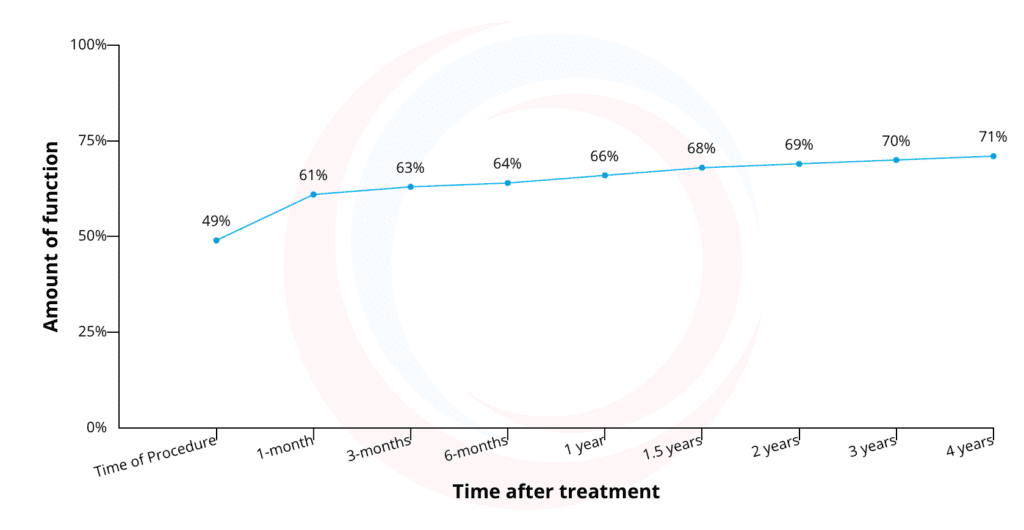In our recent blog post, The Top 10 Questions To Ask When Considering A Regenerative Procedure – Part 1, we mentioned it is important to ask a physician if they collect outcome data and, if they do, how they collect it. This article is meant to explain in detail what a Registry of Patient Outcome Data is and how its information works for you as a patient and a consumer. Also, we wanted to share the latest updates from our current outcomes data, and give an easy walkthrough of how to read the outcomes data.
What is a Patient Outcome Registry?
A patient outcome registry is where a single provider or large group of providers track patient outcomes and complications over time. When a patient engages in care with the group, there are a set of validated, measurable data points that are gathered before the procedure. This serves as their baseline, and then the patients are contacted to answer the same questions at regularly-scheduled time intervals after their procedure. The staff also follows up with patients to ensure the responses are recorded with as much completeness as possible so the outcome data reflected is accurate and complete.
This data is then plotted over time in a graph to demonstrate the patient’s improvements. Also, though, all of these patients are evaluated for complications, which is recorded in the outcome data.
A summary of the outcome data collection process for the knee, as an example, is as follows (2):
- The patient fills out standardized pain and function questionnaires for that body region. The knee includes an International Knee Documentation Committee Form (IKDC), a Lower Extremity Functional Scale (LEFS), a Numeric Pain Scale (NPS), and a subjective score of percentage improvement.
- Patients are also asked questions about whether their procedure led to any complications or side effects.
- These forms and questionnaires are filled out before the procedure and then sent at one month, three months, six months, and annually.
- The patient is pinged twice by an automated electronic system that sends email links to the questionnaires, and then two phone calls are made, and finally a letter is sent via mail. If the patient can’t be reached, that time point is dropped and he or she is picked up at the next one. If any complications are reported, these are evaluated by the treating physician as to relatedness or severity.
The Regenexx Outcome Data Difference
The Regenexx network has been collecting data from Regenexx-partner locations for many years, and has tens of thousands of outcomes to utilize in the outcomes data analysis. Regenerative medicine utilizing platelet rich plasma (PRP) and bone marrow concentrate (BMAC) is a relatively modern orthopedic technology, so this outcome data is seminal information in the field’s growing body of research. Regenexx is the only company that has tracked an orthopedic patient population of this size, and who were treated with bone marrow concentrate, for example.
In addition to discussing what an outcome registry is, it’s important to discuss what an outcome registry isn’t. Many standard physician’s offices call patients once or twice after a procedure to ask how they are feeling, and this information is recorded. However, this is input into their system as a note or documentation for internal use, it is not compiled to create an outcome data registry. A call to ask if a patient has complications is also not an outcome data registry.
In short, it is only a registry if there is an attempt to collect data in a large population at set time points, and over a long period of time.
Updates to Regenexx Patient Outcomes Data & How to Read the Data
The Regenexx network is continually collecting data from their patients. The data is continually compiled and updated to show the pain and functional improvements as reported by patients at the different time intervals post-procedure.
To view the most up-to-date data per body region, visit the Regenexx Live Outcome Data site. Here, you can select to view the outcomes from any body region, as seen in the image below.
In this article we are going to take a deep dive into the current complication of knee outcome data. So, we would select “knee” from that dropdown menu. From here, you can see the total number of patient-reported outcomes from knee procedures is 12729. Then, as pictured below, you can click a button to see the Pain, Function, or Overall Improvement for the 12729 patients who have reported on their knee procedures.
If the “Function” button is selected, a graph is displayed showing the percentage of functional improvement as reported by the patient over time.
Functional improvement is tracked at 1 month, 3 month,s 6 months, and then annually after a procedure. In the graph below, you can see that patients reported having 55% function at the time of the procedure, and had a steep incline to 73% improvement over the first year, which was maintained over the subsequent years.
Overall Function Improvement After a Regenexx Procedure
Improvements in pain are tracked at 1 month, 3 months, 6 months, and then annually after a procedure. In the graph below, pain is evaluated on a scale from 1-10, with one being minimal to no pain and 10 being extreme, unbearable pain. At the time of the procedure the average of patients reported a 4 out of 10 in their pain level. In one month, pain was reduced to 2.3 out of 10, and continued improving to 2.0 out of 10-level pain over the subsequent 3 years.
Overall Pain Improvement After a Regenexx Procedure
Last, overall improvement is tracked at 1 month, 3 month,s 6 months, and then annually after a procedure. In the graph below, you can see the average improvement at one month post-procedure was 37% improvement, 55% improvement at 6 months, and continuing to climb in improvements year over year, resulting in 60% improvement and climbing at the 4-year mark.
Overall Improvement After a Regenexx Procedure
Since no procedure or surgery out there has a 100% success-rate, the registry data is a transparent look into the efficacy of regenerative procedures per body region. Not only is this important for physicians to review when learning what new technology and techniques are growing the realm of orthopedic medicine, but patients can review what patients like them reported their outcomes to be.
If this type of improvement in pain and function is what you are looking for in your own orthopedic pain condition, we would love to see you in our office to see how we can help you.










